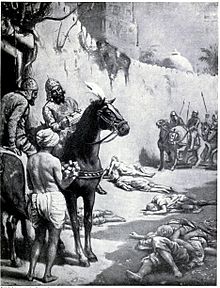| Ikhtiyar al-Din Muhammad Bakhtiyar Khalji | |||||
|---|---|---|---|---|---|
 | |||||
| Ruler of (Bengal) | |||||
| Reign | c. 1203 – 1206 | ||||
| Predecessor | (Position established) | ||||
| Successor | Muhammad Shiran Khalji | ||||
| Born | c. 1150 Garmsir, Helmand, Afghanistan | ||||
| Died | c. 1206 Devkot, South Dinajpur, West Bengal | ||||
| Burial | 1206 Pirpal Dargah, Narayanpur, Gangarampur, West Bengal | ||||
| |||||
| Clan | Khilji | ||||
| Religion | Sunni Islam | ||||
| Occupation | Military general ruler | ||||
Ikhtiyār al-Dīn Muḥammad Bakhtiyār Khaljī,[2] also known as Bakhtiyar Khalji,[3][4] was a Turko-Afghan[5][6] military general of the Ghurid ruler Muhammad of Ghor,[7] who led the Muslim conquests of the eastern Indian regions of Bengal and parts of Bihar and established himself as their ruler.[8][9][10][11] He was the founder of the Khalji dynasty of Bengal, ruling Bengal for a short period, from 1203 to 1227 CE.
Khalji's invasions of the Indian subcontinent between A.D. 1197 and 1206 led to mass flight and massacres of monks, and caused damage to the traditional Buddhist institutions of higher learning in Northern India.[12] In Bengal, Khalji's reign was responsible for the displacement of Buddhism.[13][14] The leading centre of teaching for Mahayana Buddhism was Nalanda. At the end of the 12th century, Bakhityar Khilji demolished the Monastery in a brutal sacking.[15] But some historians don't agree and reason that Bakhtiyar's attacks weren't on the Buddhist viharas, and the actual Buddhist sites were already abandoned or in declining state.[16]
His rule is said to have begun the Muslim rule in Bengal, most notably those of Bengal Sultanate and Mughal Bengal.[17]
Bakhtiyar launched an ill-fated Tibet campaign in 1206 and was assassinated upon returning to Bengal.[18][19] He was succeeded by Muhammad Shiran Khalji.
- ^ Hutchinson's story of the nations, containing the Egyptians, the Chinese, India, the Babylonian nation, the Hittites, the Assyrians, the Phoenicians and the Carthaginians, the Phrygians, the Lydians, and other nations of Asia Minor. London, Hutchinson. 1906. p. 169.
- ^ "Ikhtiyār al-Dīn Muḥammad Bakhtiyār Khiljī | Muslim general". Encyclopedia Britannica. Retrieved 9 September 2018.
- ^ Faruqui, Munis D. (2005). "Review of The Bengal Sultanate: Politics, Economy and Coins (AD 1205–1576)". The Sixteenth Century Journal. 36 (1): 246–248. doi:10.2307/20477310. ISSN 0361-0160. JSTOR 20477310.
Hussain argues ... was actually named Muhammad Bakhtiyar Khalji and not the broadly used Muhammad bin Bakhtiyar Khalji
- ^ Hussain, Syed Ejaz (2003). The Bengal Sultanate: Politics, Economy and Coins (AD 1205–1576). New Delhi: Manohar. p. 27. ISBN 9788173044823.
- ^ Know Your State West Bengal. Arihant Experts. 2019. p. 15.
Turk-Afghan Rule: Muhammad Bakhtiyar Khilji's invasion to Bengal marked the advent of Turk-Afghan rule in Bengal.
- ^ Chandra, Satish (2004). Medieval India: From Sultanat to the Mughals-Delhi Sultanat (1206-1526). p. 226.
Although the Afghans formed a large group in the army of the Delhi Sultanat, only few Afghan nobles had been accorded important positions. That is why Bakhtiyar Khalji who was part - Afghan had to seek his fortune in Bihar and Bengal.
- ^ Turkish History and Culture in India: Identity, Art and Transregional Connections. BRILL. 17 August 2020. p. 237. ISBN 978-90-04-43736-4.
- ^ Majumdar, R. C. (1973). History of Mediaeval Bengal. Calcutta: G. Bharadwaj & Co. pp. 1–2. OCLC 1031074.
Tradition gives him credit for the conquest of Bengal but as a matter of fact he could not subjugate the greater part of Bengal ... All that Bakhtyār can justly take credit for is that by his conquest of Western and a part of Northern Bengal he laid the foundation of the Muslim State in Bengal. The historians of the 13th century never attributed the conquest of the whole of Bengal to Bakhtyār.
- ^ Mehta, Jaswant Lal (1986) [First published 1979]. Advanced Study in the History of Medieval India. Vol. I (2nd ed.). Sterling Publishers. pp. 81–82. ISBN 978-81-207-0617-0. OCLC 883279992.
The Turkish arms penetrated into Bihar and Bengal through the enterprising efforts of Ikhtiyaruddin Muhammad bin Bakhtiyar Khalji ... he started plundering raids into Bihar and, within four or five years, occupied a large part of it ... Nadia was sacked by the Turks and a few districts of Bengal (Malda, Dinajpur, Murshidabad and Birbhum) were occupied by them ... Bathtiyar Khalji could not retain his hold over Nadia and made Lakhnauti or Gaur as his capital.
- ^ Thakur, Amrendra Kumar (1992). India and the Afghans: A study of a neglected region, 1370–1576 A.D. Janaki Prakashan. p. 148. ISBN 9788185078687.
- ^ Ahmed, Salahuddin (2004). Bangladesh: Past and Present. APH. p. 59. ISBN 9788176484695.
- ^ Scharfe, Hartmut (2002). Handbook of Oriental Studies. BRILL. p. 150. ISBN 90-04-12556-6.
Nalanda, together with the colleges at Vikramasila and Odantapuri, suffered gravely during the conquest of Bihar by the Muslim general Muhammad Bhakhtiyar Khalji between A.D. 1197 and 1206, and many monks were killed or forced to flee.
- ^ Arnold, Sir Thomas Walker (1896). The Preaching of Islam: A History of the Propagation of the Muslim Faith. Archibald Constable and Co. pp. 227–228.
- ^ Hindu-Muslim Relations in Bengal, 1905–1947: Study in Cultural Confrontation, Page 11, Nachiketa Publications, 1974, Hossainur Rahman
- ^ "Ancient Nalanda University's Ruins | District Nalanda, Government of Bihar | India". Retrieved 22 June 2024.
- ^ Salam, Ziya Us (18 July 2024). "Of a gilded past and the future: Nalanda's lost glory and new-found ambitions". The Hindu. ISSN 0971-751X. Retrieved 18 July 2024.
- ^ Eaton, Richard Maxwell (1996). The Rise of Islam and the Bengal Frontier, 1204–1760. University of California Press. pp. 28–34. ISBN 9780520205079.
- ^ Cite error: The named reference
Sengupta2011was invoked but never defined (see the help page). - ^ Cite error: The named reference
GillYule2010was invoked but never defined (see the help page).